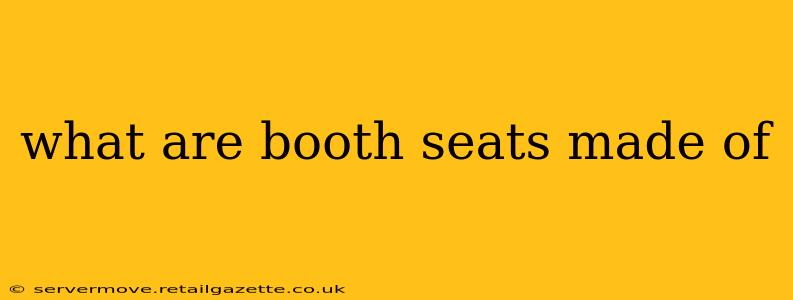Restaurant booth seating offers a cozy and intimate dining experience, but have you ever wondered what materials go into creating those comfortable and stylish benches? The answer is more diverse than you might think! Booth seats are constructed using a variety of materials, each offering unique benefits and drawbacks in terms of durability, comfort, cleaning, and overall cost. Let's explore the most common components.
What are the Frames of Restaurant Booths Made Of?
The foundation of any booth lies in its frame. This is often the most durable part, designed to withstand years of use and potential wear and tear. Popular materials include:
- Wood: Hardwoods like oak and maple are favored for their strength and longevity. They can be stained or painted to match any décor. However, wood requires regular maintenance to prevent damage from spills and moisture.
- Metal: Steel or aluminum frames offer exceptional durability and are often chosen for their resistance to damage. Metal frames are typically powder-coated for a more aesthetically pleasing finish and protection against rust.
- MDF (Medium-Density Fiberboard): MDF is a more budget-friendly option, providing a sturdy base, but it's less durable than hardwood or metal in the long run and susceptible to moisture damage.
What are Booth Seat Cushions Filled With?
The comfort of a booth seat is largely determined by its cushion filling. Several options exist, each offering different levels of firmness, resilience, and longevity:
- Foam: This is the most common filling material. Different foam densities offer varying degrees of firmness and support. High-density foam is more durable and provides better support, but it's also more expensive. Lower-density foam is softer and more comfortable initially but may lose its shape over time.
- Polyester Fiberfill: This softer, fluffier material offers a less structured feel than foam, providing a comfortable yet less supportive seating experience. It's typically used in combination with foam for added comfort and resilience.
- Down or Feather Filling: While less common in commercial settings due to cost and maintenance concerns, down or feather-filled cushions offer luxurious comfort. However, these are more susceptible to wear and tear and require more specialized cleaning.
What are Booth Seat Upholstery Materials?
The upholstery is what you see and interact with most. It dictates the look, feel, and ease of cleaning. A variety of materials are available:
- Vinyl: A popular choice for its durability, ease of cleaning, and affordability. Vinyl is highly resistant to stains and moisture, making it ideal for high-traffic areas. However, it can feel less comfortable than fabric options.
- Leather: Offers a luxurious look and feel, providing exceptional durability and lasting elegance. Leather is relatively easy to clean, but it's significantly more expensive than vinyl or fabric.
- Fabric: A wide range of fabrics, including polyester, cotton, linen, and microfiber, can be used for upholstery. Fabric offers a softer feel than vinyl or leather, but it's generally less durable and requires more frequent cleaning. Consider stain-resistant treatments for higher durability.
What are Some Less Common Booth Seat Materials?
While the above materials are most common, you might occasionally encounter others:
- Recycled Materials: Increasingly, manufacturers are using recycled materials in booth construction to promote sustainability. This might include recycled foam, wood, or fabrics.
- Outdoor-Suitable Materials: For patios or outdoor dining areas, materials like weather-resistant fabrics and marine-grade vinyl are used to withstand the elements.
How Do I Choose the Right Booth Seat Materials?
Selecting the appropriate materials depends on several factors:
- Budget: The cost varies significantly between materials. Vinyl and MDF are budget-friendly, while leather and high-density foam are more expensive.
- Durability: Consider the level of wear and tear your booth seats will endure. High-traffic areas might benefit from more durable materials like vinyl or metal frames.
- Style: The aesthetic you want to achieve will influence the choice of upholstery and frame materials.
- Maintenance: Think about how much time and effort you're willing to dedicate to cleaning and maintenance. Vinyl and leather are easy to clean, while fabric requires more attention.
By understanding the different materials used in booth seat construction, you can make an informed decision that meets your needs in terms of style, comfort, durability, and budget. Remember to consider the long-term implications of your choices to ensure your booths remain comfortable and stylish for years to come.
